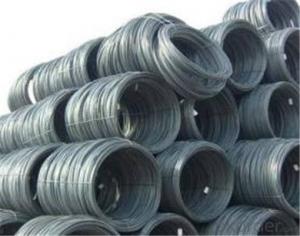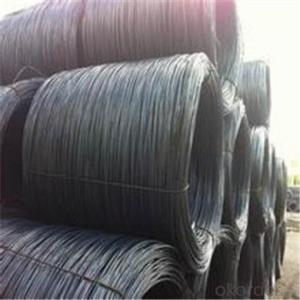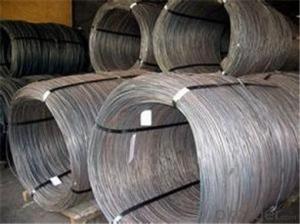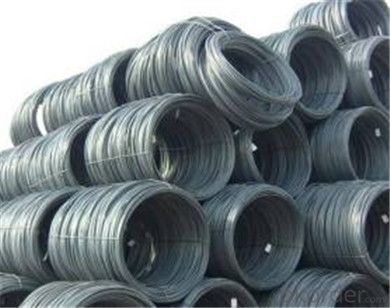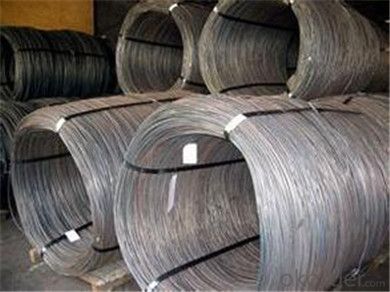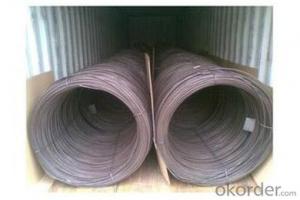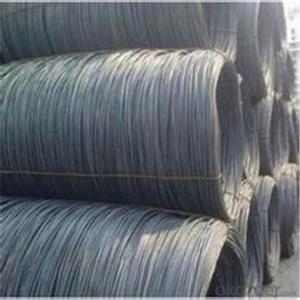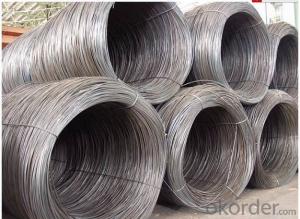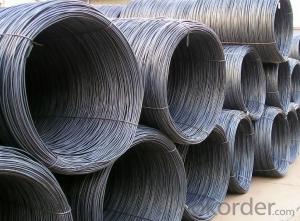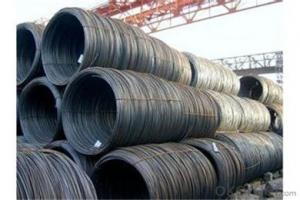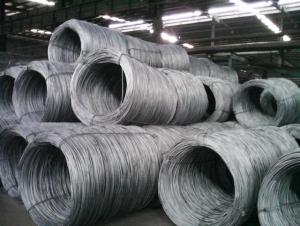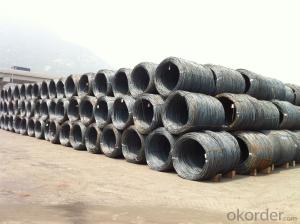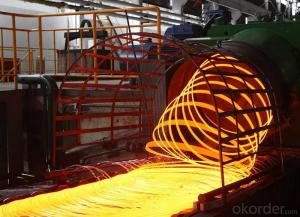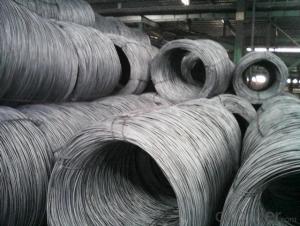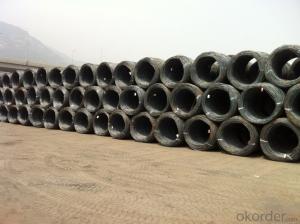SAE1008Gr Steel Wire rod 5.5mm with Best Quality
- Loading Port:
- Shanghai
- Payment Terms:
- TT OR LC
- Min Order Qty:
- 99 m.t.
- Supply Capability:
- 45555555 m.t./month
OKorder Service Pledge
OKorder Financial Service
You Might Also Like
Specification
Description of wire Rod:
wire rod:
Grade:SAE1006B/SAE1008B/SAE1018B
Size:5.5/6.5/7/8/9/10/11/12mm
Festures of wire Rod:
1. Drawn wire specialist, your wire rod solution
2. ISO9001 Certified Mill &SGS
3. Feature: machinability, high hardness, toughness, corrosion resistant
4. Clear and smooth surface, high precision and Tolerance control: ± 0.01
5. Customized service for your special requirement
6. Reasonable and more competitive mill price for you.
Specifications of wire Rod:
Grade | Chemical Composition(%) | |||||
C | Mn | Si | S | P | Cr | |
SAE1008B | 0.10max | 0.3~O.50 | 0.15max | 0.050max | 0.040 max | 0.3-0.35 |
Mechanical properties | ||||||
Yield strength(N/mm2) | Tensile strength(N/mm2) | Elongation(%) | ||||
≥195 | 315-430 | ≥30 | ||||
| Packaging Details: | (1) Coils are wrapped by 8 steel strips; (2) Wrapped by waterproof cloth; (3) Wrapped by 8 steel strips (6+2) ; (4) Added with wood pallet |
Images of wire Rod:
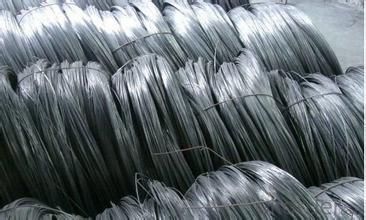
FAQ:
1. What is your package?
Packing situation: standard seaworthy packing or as customer required.
2. How long is the lead time?
Delivery time: 45 days after order confirmed.
3. What payment term do you accept?
Payment: T/T or L/C at sight.
- Q: How is steel wire rod used in the production of conveyor belts?
- Steel wire rod is used in the production of conveyor belts as the main reinforcement component. It is typically formed into a spiral or helix shape and embedded in the rubber or plastic material of the belt. This reinforcement provides strength and durability to the conveyor belt, allowing it to withstand heavy loads and continuous movement. Additionally, the steel wire rod enhances the flexibility and stability of the belt, ensuring smooth and efficient transportation of materials.
- Q: Types of wire rods
- There are many kinds of wire rods. Carbon steel wire rod in the low carbon steel wire rod, commonly known as cord, medium and high carbon steel wire rod commonly known as hard wire. Wire rods are mainly used for drawing billets, and can be used directly as building materials and machined into mechanical parts. Stainless steel wire rod is used for making stainless steel wire, stainless steel spring steel wire, stainless steel wire and stainless steel wire rope. With the development of production technology, square has appeared,
- Q: How is the decarburization of steel wire rod evaluated?
- The decarburization of steel wire rod is evaluated through various methods and techniques to ensure the quality and properties of the final product. One common evaluation method is through visual inspection, where the surface of the wire rod is examined for any signs of decarburization such as discoloration or scaling. This can provide a preliminary assessment of the level of decarburization. In addition to visual inspection, chemical analysis is performed to determine the carbon content at different depths of the wire rod. This is usually done by taking samples from different sections of the wire rod and subjecting them to a carbon analysis test. The results of this analysis can reveal the extent of decarburization and help in assessing its impact on the mechanical properties of the steel wire rod. Microscopic examination is also an important evaluation technique. Metallographic analysis involves preparing thin sections of the wire rod and examining them under a microscope. This allows for a detailed examination of the microstructure and identification of any decarburized areas. The depth and severity of decarburization can be measured using specialized equipment, such as image analysis software, which helps quantify the decarburization depth. Furthermore, mechanical testing is conducted to assess the impact of decarburization on the wire rod's mechanical properties. Tensile strength, hardness, and ductility tests are commonly performed to evaluate the wire rod's overall strength and behavior under different conditions. Any significant deviation from the desired mechanical properties may indicate a higher level of decarburization. Overall, the evaluation of decarburization in steel wire rod involves a combination of visual inspection, chemical analysis, microscopic examination, and mechanical testing. These techniques provide a comprehensive understanding of the extent and impact of decarburization, ensuring that the wire rod meets the required quality standards and specifications.
- Q: What are the common applications of pre-stressed concrete steel wire rod?
- Pre-stressed concrete steel wire rods are widely used in various applications due to their high strength and durability. Some of the common applications of pre-stressed concrete steel wire rods are: 1. Buildings and Infrastructure: Pre-stressed concrete steel wire rods are commonly used in the construction of buildings, bridges, highways, and other infrastructure projects. They provide added strength and load-bearing capacity to the structures, making them resistant to bending, cracking, and other forms of structural failure. 2. Post-tensioning Systems: Pre-stressed concrete steel wire rods are extensively used in post-tensioning systems. These systems involve the insertion of pre-stressed steel wire rods into concrete structures and then applying tension to them. This process helps to counteract the tensile forces that concrete structures experience, thereby improving their overall strength and durability. 3. Precast Concrete Products: Pre-stressed concrete steel wire rods are also used in the production of precast concrete products such as beams, columns, slabs, and walls. By incorporating pre-stressed steel wire rods during the manufacturing process, these products gain enhanced strength and resistance to cracking, allowing for longer spans and thinner sections. 4. Retaining Walls: Pre-stressed concrete steel wire rods play a crucial role in the construction of retaining walls. These walls are designed to retain soil and prevent erosion. By integrating pre-stressed steel wire rods into the concrete structure, the retaining walls become more robust, ensuring stability and preventing any potential failure due to the pressure exerted by the retained soil. 5. Seismic Resistant Structures: Pre-stressed concrete steel wire rods are especially valuable in seismic regions where earthquakes are a concern. By incorporating pre-stressed steel wire rods into the concrete elements of buildings and infrastructure, their ability to withstand seismic forces is significantly increased. This helps to minimize damage and ensure the safety of occupants during earthquakes. Overall, the common applications of pre-stressed concrete steel wire rods encompass a wide range of construction projects, where their strength, durability, and ability to withstand various forces are essential.
- Q: What are the different mechanical properties of steel wire rod?
- The different mechanical properties of steel wire rod include high tensile strength, good ductility, excellent toughness, and high fatigue resistance. Additionally, steel wire rod exhibits low deformation under stress, good formability, and high resistance to corrosion.
- Q: What are the common production processes for aluminum-coated steel wire rod?
- The common production processes for aluminum-coated steel wire rod include cleaning and pickling the steel rod, applying a layer of aluminum through hot-dipping or electroplating, and then undergoing further processes such as drying, cooling, and coiling to create the final aluminum-coated steel wire rod product.
- Q: What are the main factors influencing the choice of steel wire rod warranty?
- The choice of steel wire rod warranty is influenced by several key factors. Firstly, the quality of the steel wire rod is crucial. Buyers prefer a high-quality product that is unlikely to have defects or issues, reducing the need for warranty claims. Factors such as strength, durability, and overall performance play a significant role in determining confidence in the product and, consequently, the warranty. Secondly, the reputation of the manufacturer is another important consideration. Buyers are more likely to trust a manufacturer with a proven track record of producing high-quality steel wire rods and providing reliable warranties. Positive reviews, testimonials, and references from other customers can provide valuable insights into the manufacturer's commitment to customer satisfaction and after-sales service. Lastly, the terms and conditions of the warranty itself are essential. Buyers carefully consider factors such as the duration of the warranty, the extent of coverage it offers, and any limitations or exclusions stated in the warranty documentation. A longer warranty period and comprehensive coverage, including protection against manufacturing defects or premature failure, are often preferred. Additionally, factors such as the process for filing warranty claims, the responsiveness of the manufacturer's customer service, and the ease of warranty fulfillment are also taken into account. To summarize, the main factors influencing the choice of steel wire rod warranty are the quality of the product, the reputation of the manufacturer, and the terms and conditions of the warranty. Buyers prioritize a high-quality product, a reputable manufacturer, and a warranty with favorable terms and comprehensive coverage.
- Q: What are the different types of coatings used on steel wire rod?
- There are various types of coatings used on steel wire rods, each serving a specific purpose and providing unique benefits. Some common types of coatings include: 1. Zinc Coating: Zinc is one of the most widely used coatings for steel wire rods. It provides excellent corrosion resistance, acting as a protective barrier between the steel and the surrounding environment. Zinc coatings can be applied through hot-dip galvanizing or electroplating processes. 2. Polymer Coating: Polymer coatings are often applied to steel wire rods to enhance their durability and resistance to abrasion. These coatings can be made from various types of polymers, such as polyethylene or polypropylene, and are often applied through extrusion processes. 3. Phosphate Coating: Phosphate coatings are used to improve the adhesion between the steel wire rod and subsequent coatings or paints. They provide a rough surface that enhances the bonding ability of other coatings, thereby increasing their effectiveness. 4. Epoxy Coating: Epoxy coatings are commonly used for steel wire rods that will be exposed to harsh environments, such as marine or industrial applications. These coatings offer excellent chemical resistance and durability, protecting the steel from corrosion and other forms of degradation. 5. Chrome Coating: Chrome coatings provide a highly polished and decorative finish to steel wire rods. They are often used in applications where aesthetics are important, such as in the manufacturing of furniture or automotive components. 6. Nickel Coating: Nickel coatings are used to enhance the corrosion resistance of steel wire rods in highly corrosive environments, such as marine or chemical processing applications. Nickel coatings can be applied through electroplating processes. 7. Copper Coating: Copper coatings are applied to steel wire rods to improve their electrical conductivity. They are often used in applications where the wire rod will be used for electrical purposes, such as in wiring systems or electronic devices. It is important to note that the choice of coating for a steel wire rod will depend on the specific application and the desired properties of the finished product. Furthermore, some coatings can be combined or modified to achieve specific performance requirements.
- Q: What are the different packaging materials used for steel wire rod?
- Packaging materials for steel wire rods vary based on factors such as length, weight, protection needed during transportation, and ease of handling. Commonly used materials include steel coils, wooden reels, pallets, cardboard boxes, and plastic wraps. Steel coils are a popular option, as they provide compact and secure packaging that is easy to transport and handle. For longer and heavier wire rods, wooden reels offer a larger and more stable packaging solution, commonly used in construction and industrial applications. Pallets are another option, providing a stable base for wire rods and enabling easy handling with forklifts or pallet jacks. Cardboard boxes are suitable for smaller or specific length wire rods, offering protection during transportation and facilitating storage. In some cases, plastic wraps are used for steel wire rods, particularly when smaller quantities need protection from moisture or dust during transportation. It should be noted that the choice of packaging material depends on the specific requirements of the manufacturer and end user, as well as factors like cost, transportation method, and storage conditions.
- Q: What are the different international specifications for steel wire rod?
- There are several international specifications for steel wire rod, including the ASTM (American Society for Testing and Materials) standards, the EN (European Norm) standards, and the JIS (Japanese Industrial Standards) standards. These specifications outline the requirements for various properties of steel wire rod, such as its chemical composition, mechanical properties, and dimensions. They ensure that steel wire rod produced and used globally meets specific quality and performance standards.
Send your message to us
SAE1008Gr Steel Wire rod 5.5mm with Best Quality
- Loading Port:
- Shanghai
- Payment Terms:
- TT OR LC
- Min Order Qty:
- 99 m.t.
- Supply Capability:
- 45555555 m.t./month
OKorder Service Pledge
OKorder Financial Service
Similar products
Hot products
Hot Searches
Related keywords
